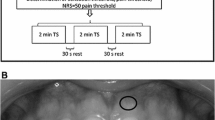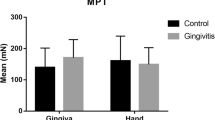Abstract
The aim of this study was to investigate temporal and spatial aspects of somatosensory changes after topical application of capsaicin, menthol and local anesthetics (LA) on the gingiva with the use of intraoral palpometers and thermal devices. Sixteen healthy volunteers (eight male, eight female) participated. Four topical preparations (capsaicin, menthol, LA and Vaseline as a control) were randomly applied to the gingiva around the first premolar in the upper jaw via individual oral templates, which allowed spatial mapping of somatosensory changes at and adjacent to the site of application. The topical drugs were applied for 15 min in a randomized and balanced sequence. The perceived preparation-evoked pain intensity was recorded with the use of 0–10 visual analog scales (VAS). Standardized mechanical and thermal stimuli were applied before, during and up to 30 min after the topical applications, and numerical rating scales (NRS) were used to score the perceived intensity of the stimuli. Peak VAS, area under the curve and mean VAS preparation-evoked pain scores for capsaicin, menthol, LA and control were compared with paired t tests. NRS scores for mechanical and thermal test stimuli were analyzed with four-way repeated measurements analyses of variance. Capsaicin evoked significantly higher VAS pain parameters as well as higher NRS scores to heat stimuli than control (P < 0.029). There were no significant differences in stimulus-evoked NRS scores between the menthol and control conditions (P = 0.518), but LA caused significantly lower stimulus-evoked NRS scores compared with control (P < 0.001). Post hoc tests showed that capsaicin caused sensitization to heat stimuli at and adjacent to the application area. In conclusion, this study for the first time demonstrates the time course of capsaicin-evoked heat hyperalgesia in and outside the site of application at the oral mucosa (primary and secondary hyperalgesia).




Similar content being viewed by others
References
Ali Z, Meyer RA, Campbell JN (1996) Secondary hyperalgesia to mechanical but not heat stimuli following a capsaicin injection in hairy skin. Pain 68:401–411
Andersen OK, Yucel A, Arendt-Nielsen L (2001) Human models of hyperalgesia induced by capsaicin: A discussion of secondary hyperalgesia to heat. In: Harden RN, Barron R, Jänig W (eds) Complex regional pain syndrome. IASP Press, Seattle, pp 165–181
Arendt-Nielsen L, Bjerring P (1988) Laser-induced pain for evaluation of local analgesia: a comparison of topical application (EMLA) and local injection (lidocaine). Anesth Analg 67:115–123
Arendt-Nielsen L, Bjerring P (1989) The effect of topically applied anaesthetics (EMLA cream) on thresholds to thermode and argon laser stimulation. Acta Anaesthesiol Scand 33:469–473
Baad-Hansen L, Jensen TS, Svensson P (2003) A human model of intraoral pain and heat hyperalgesia. J Orofac Pain 17:333–340
Baad-Hansen L, Poulsen HF, Jensen HM, Svensson P (2005) Lack of sex differences in modulation of experimental intraoral pain by diffuse noxious inhibitory controls (DNIC). Pain 116:359–365
Baad-Hansen L, List T, Jensen TS, Svensson P (2006) Increased pain sensitivity to intraoral capsaicin in patients with atypical odontalgia. J Orofac Pain 20:107–114
Baad-Hansen L, Pigg M, Ivanovic SE, Faris H, List T, Drangsholt M, Svensson P (2013) Intraoral somatosensory abnormalities in patients with atypical odontalgia: a controlled multicenter quantitative sensory testing study. Pain 154:1287–1294
Baumann TK, Simone DA, Shain CN, LaMotte RH (1991) Neurogenic hyperalgesia: the search for the primary cutaneous afferent fibers that contribute to capsaicin-induced pain and hyperalgesia. J Neurophysiol 66:212–227
Binder A, Stengel M, Klebe O, Wasner G, Baron R (2011) Topical high-concentration (40%) menthol-somatosensory profile of a human surrogate pain model. J Pain 12:764–773
Campbell CM, Bounds SC, Simango MB, Witmer KR, Campbell JN, Edwards RR, Haythornthwaite JA, Smith MT (2011) Self-reported sleep duration associated with distraction analgesia, hyperemia, and secondary hyperalgesia in the heat-capsaicin nociceptive model. Eur J Pain 15:561–567
Caterina MJ, Schumacher MA, Tominaga M, Rosen TA, Levine JD, Julius D (1997) The capsaicin receptor: a heat-activated ion channel in the pain pathway. Nature 389:816–824
Caterina MJ, Leffler A, Malmberg AB, Martin WJ, Trafton J, Petersen-Zeitz KR, Koltzenburg M, Basbaum AL, Julius D (2000) Impaired nociception and pain sensation in mice lacking the capsaicin receptor. Science 288:306–313
Cliff MA, Green BG (1994) Sensory irritation and coolness produced by menthol: evidence for selective desensitization of irritation. Physiol Behav 56:1021–1029
Cruccu G, Truini A (2009) Tools for assessing neuropathic pain. PLoS Med 6:e1000045
Cruccu G, Sommer C, Anand P, Attal N, Baron R, Garcia-Larrea L, Haanpaa M, Jensen TS, Serra J, Treede RD (2010) EFNS guidelines on neuropathic pain assessment: revised 2009. Eur J Neurol 17:1010–1018
Dahl JB, Brennum J, Arendt-Nielsen L, Jensen TS, Kehlet H (1993) The effect of pre- versus postinjury infiltration with lidocaine on thermal and mechanical hyperalgesia after heat injury to the skin. Pain 53:43–51
Fluhr K, Neddermeyer TJ, Lotsch J (2009) Capsaicin or menthol sensitization induces quantitative but no qualitative changes to thermal and mechanical pain thresholds. Clin J Pain 25:128–131
Geber C, Baumgartner U, Schwab R, Muller H, Stoeter P, Dieterich M, Sommer C, Birklein F, Treede RD (2009) Revised definition of neuropathic pain and its grading system: an open case series illustrating its use in clinical practice. Am J Med 122:S3–S12
Geber C, Klein T, Azad S, Birklein F, Gierthmuhlen J, Huge V, Lauchart M, Nitzsche D, Stengel M, Valet M, Baron R, Maier C, Tolle T, Treede RD (2011) Test-retest and interobserver reliability of quantitative sensory testing according to the protocol of German research network on neuropathic pain (DFNS): a multi-centre study. Pain 152:548–556
Green BG (1996) Rapid recovery from capsaicin desensitization during recurrent stimulation. Pain 68:245–253
Green BG (1998) Capsaicin desensitization and stimulus-induced recovery on facial compared to lingual skin. Physiol Behav 65:517–523
Haten S, Attal N, Willer JC, Bouhassira D (2006) Psychophysical study of the effects of topical application of menthol in healthy volunteers. Pain 122:190–196
Kilo S, Schmelz M, Koltzenburg M, Handwerker HO (1994) Different patterns of hyperalgesia induced by experimental inflammation in human skin. Brain 117:385–396
Koltzenburg M, Lundberg LER, Torebjörk HE (1992) Dynamic and static components of mechanical hyperalgesia in human hairy skin. Pain 51:207–219
Kosek E, Ekholm J, Hansson P (1999) Pressure pain thresholds in different tissues in one body region. The influence of skin sensitivity in pressure algometry. Scand J Rehabil Med 31:89–93
LaMotte RH, Shain CN, Simone DA, Tsai EF (1991) Neurogenic hyperalgesia: psychophysical studies of underlying mechanisms. J Neurophysiol 66:190–211
Lu S, Baad-Hansen L, List T, Zhang Z, Svensson P (2013a) Somatosensory profiling of intra-oral capsaicin and menthol in healthy subjects. Eur J Oral Sci 121:29–35
Lu S, Baad-Hansen L, Zhang Z, Svensson P (2013b) Reliability of new technique for intraoral mapping of somatosensory sensitivity. Somatosens Mot Res 30:30–36
Mckemy DD, Neuhausser WM, Julius D (2002) Identification of a cold receptor reveals a general role for TRP channels in thermosensation. Nature 416:52–58
Naganawa T, Iida T, Baad-Hansen L, Ando T, Svensson P (2013) Application of a new palpometer for intraoral mechanical pain sensitivity assessment. J Orofac Pain 27:336–342
Naganawa T, Baad-Hansen L, Iida T, Svensson P (2015) Assessment of human intraoral thermal sensitivity with a simple device: Implication and applicability for orofacial pain conditions. J Oral Facial Pain Headache (in press)
Namer B, Kleggetveit IP, Handwerker H, Schmelz M, Jorum E (2008) Role of TRPM8 and TRPV1 for cold allodynia in patients with cold injury. Pain 139:63–72
Ngom PI, Dubray C, Woda A, Dallel R (2001) A human oral capsaicin pain model to assess topical anesthetic-analgesic drugs. Neurosci Lett 316:149–152
Petersen KL, Rowbotham MC (1999) A new human experimental pain model: the heat/capsaicin sensitization model. Neuroreport 14:1511–1516
Pigg M, Baad-Hansen L, Svensson P, Drangsholt M, List T (2010) Reliability of intraoral quantitative sensory testing (QST). Pain 148:220–226
Raja SN, Campbell JN, Meyer RA (1984) Evidence for different mechanisms of primary and secondary hyperalgesia following heat injury to the glabrous skin. Brain 107:1179–1188
Roberts K, Shenoy R, Anand P (2011) A novel human volunteer pain model using contact feat evoked potentials (CHEP) following topical skin application of transient receptor potential agonists capsaicin, menthol and cinnamaldehyde. J Clin Neurosci 18:926–932
Rolke R, Baron R, Maier C, Tolle TR, Treede RD, Beyer A, Binder A, Birbaumer N, Birkelein F, Botefur IC, Braune S, Flor H, Huge V, Klug R, Landwehrmeyer GB, Magerl W, Maihofner C, Rolko C, Schaub C, Scherens A, Sprenger T, Valet M, Wasserka B (2006) Quantitative sensory testing in the German research network on neuropathic pain (DFNS): standardized protocol and reference values. Pain 123:231–243
Serra J, Campero M, Bostock H, Ochoa J (2004) Two types of C nociceptors in human skin and their behavior in areas of capsaicin-induced secondary hyperalgesia. J Neurophysiol 91:2770–2781
Sessle BJ (1987) The neurobiology of facial and dental pain: present knowledge, future directions. J Dent Res 66:962–981
Simone DA, Baumann TK, LaMotte RH (1989) Dose-dependent pain and mechanical hyperalgesia in human after intradermal injection of capsaicin. Pain 38:99–107
Svensson P, Bjerring P, Arendt-Nielsen L, Kaaber S (1992) Hypoalgesic effect of EMLA and lidocaine gel applied on human oral mucosa: quantitative evaluation by sensory and pain thresholds to argon laser stimulation. Anesth Prog 39:4–8
Svensson P, Graven-Nielesen T, Arendt-Nielsen L (1998) Mechanical hyperesthesia of human facial skin induced by tonic painful stimulation of jaw muscle. Pain 74:93–100
Torebjörk HE, Lundberg LE, LaMotte RH (1992) Central changes in processing of mechanoreceptive input in capsaicin-induced secondary hyperalgesia in human. J Physiol 448:765–780
Treede RD, Jensen TS, Campbell JN, Cruccu G, Dostrovsky JO, Griffin JW, Hansson P, Hughes R, Nurmikko T, Serra J (2008) Neuropathic pain: redefinition and a grading system for clinical and research purposes. Neurology 70:1630–1635
Wasner G, Schattschneider J, Binder A, Baron R (2004) Topical menthol—a human model for cold pain by activation and sensitization of C nociceptors. Brain 127:1159–1171
Xing H, Chen M, Ling J, Tan W, Gu JG (2007) TRPM8 mechanism of cold allodynia after chronic nerve injury. J Neurosci 27:13680–13690
Acknowledgments
The Danish Dental Association is acknowledged for their support to the study.
Author information
Authors and Affiliations
Corresponding author
Rights and permissions
About this article
Cite this article
Naganawa, T., Baad-Hansen, L., Ando, T. et al. Influence of topical application of capsaicin, menthol and local anesthetics on intraoral somatosensory sensitivity in healthy subjects: temporal and spatial aspects. Exp Brain Res 233, 1189–1199 (2015). https://doi.org/10.1007/s00221-015-4200-5
Received:
Accepted:
Published:
Issue Date:
DOI: https://doi.org/10.1007/s00221-015-4200-5




